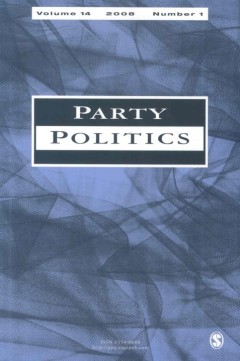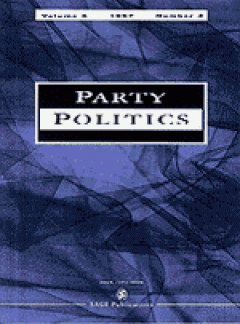Filter by

Party Non-Systems: A Conceptual Innovation
This article makes a case for expansion of the conceptual framework for the classification of party universe types. In particular, it introduces the concept of `party non-systems', defined as those party universes characterized by a fundamental absence of inter-temporal continuity in the identity of the main parties. At the heart of this concept is the explicit differentiation between intra- an…
- Edition
- Volume 15, Number 4, July 2009. pp. 487-520
- ISBN/ISSN
- 1354-0688
- Collation
- -
- Series Title
- Party Politics
- Call Number
- -

Still Talking, But Is Anyone Listening?: The Changing Face of Constituency Ca…
Constituency electioneering has become established as an important element of postmodern political campaigning, allowing parties and candidates to focus effort on targeted seats. A substantial literature has developed, showing the efficacy of such targeting: other things being equal, the harder parties� campaign locally, the more votes they win relative to their rivals. However, on the whole, s…
- Edition
- Volume 15, Number 4, July 2009. pp. 411-434
- ISBN/ISSN
- 13540688
- Collation
- -
- Series Title
- Party Politics
- Call Number
- -

‘Empty Nets’: Social Democracy and the ‘Catch-All Party Thesis’ in Ge…
The Social Democratic parties of Germany and Sweden were part of �third way� movements common to such political parties during the mid-1990s. By continuing to moderate their positions and move away from their traditional bases towards the centre, they seemed to embody � a generation later � a second embracing of Kirchheimer�s �catch-all� party thesis. But unlike its 1960s� incarnation, each of …
- Edition
- Vol. 15, No. 5, September 2009.pp. 635-653
- ISBN/ISSN
- 13540688
- Collation
- -
- Series Title
- Party Politics
- Call Number
- -

Holding Their Own: Explaining the Persistence of Green Parties in France and …
In his seminal work, Kirchheimer (1966) argued that as larger parties transformed into catch-all parties we would see the disappearance of small parties. We know, however, that Green parties are one example of small parties that have persisted in many European party systems. In this article, I seek to explain this inconsistency. I argue that Kirchheimer did not anticipate the development and gr…
- Edition
- Vol. 15, No. 5, September 2009.pp. 615-634
- ISBN/ISSN
- 13540688
- Collation
- -
- Series Title
- Party Politics
- Call Number
- -

Campaigning and the Catch-All Party: The Process of Party Transformation in B…
Otto Kirchheimer�s well-known diagnosis of �catch-all� partism in Western Europe rests on an implicit causal argument about the consequences of social change for political parties. This article takes up the causal story underlying Kirchheimer�s account and traces its implications for a specific, though central, party activity: campaigning. As Kirchheimer discerned, the transformation of advance…
- Edition
- Vol. 15, No. 5, September 2009.pp. 555-572
- ISBN/ISSN
- 13540688
- Collation
- -
- Series Title
- Party Politics
- Call Number
- -

Kirchheimer Italian Style: Catch-All Parties or Catch-All Blocs
In this article, I use the Italian case to demonstrate that Kirchheimer�s catch-all thesis can be applied in various ways. Unlike parties in many European nations, Italian parties did not undergo a catch-all transformation in the post-war period. However, after the parties and party system were dramatically reformed in the 1990s, some catch-all characteristics � with clarifications � in Italy a…
- Edition
- Vol. 15, No. 5, September 2009.pp. 573-591
- ISBN/ISSN
- 1354-0688
- Collation
- -
- Series Title
- Party Politics
- Call Number
- -

The Catch-All Party Revisited: Reflections of a Kirchheimer Student
This article aims to do the following: reflect upon the life, experiences, ideas and teaching of Kirchheimer from the perspective of the author, his first dissertation advisee at Columbia University and one of his last students; discuss some of his major political observations and arguments; and consider their relevance today.
- Edition
- Vol. 15, No. 5, September 2009.pp. 543-554
- ISBN/ISSN
- 13540688
- Collation
- -
- Series Title
- Party Politics
- Call Number
- -

Kirchheimer’s French Twist: A Model of the Catch-All Thesis Applied to the …
Despite the fact that the catch-all thesis has profoundly affected scholarship on political parties, operationalizing the thesis and applying it to evaluate empirical cases has proved challenging for scholars. The thesis has been criticized for lacking a theoretical framework of analysis and clear causal logic. Therefore, while it is often cited it is rarely tested. In this article I develop a …
- Edition
- Vol. 15, No. 5, September 2009.pp. 592-614
- ISBN/ISSN
- 13540688
- Collation
- -
- Series Title
- Party Politics
- Call Number
- -

Dissent in a Party-Based Parliament: The Portuguese Case
With a focus on the Portuguese case, this article shows how MPs express disagreement with their parties in a highly cohesive and party-dominated parliament. We review the features that explain why the Portuguese institutional framework reinforces party control over the parliamentary mandate and discuss the different ways Portuguese MPs express party dissent. In the last section of the article, …
- Edition
- Vol. 15, No. 6, November 2009.pp. 695-713
- ISBN/ISSN
- 13540688
- Collation
- -
- Series Title
- Party Politics
- Call Number
- -

Party Behaviour in the Parliamentary Arena: The Case of the Korean National A…
This article investigates the nature of party behaviour in the legislative arena in a developing democracy by undertaking a spatial analysis of voting in the Korean National Assembly. We discover the main dimensions of politics in the Korean parliament and look at how KNA members� ideological preferences, regional interests and the shift from divided to unified government shapes relations betwe…
- Edition
- Vol. 15, No. 6, November 2009.pp. 667-694
- ISBN/ISSN
- 13540688
- Collation
- -
- Series Title
- Party Politics
- Call Number
- -

Gender and Political Party Leadership in Canada
In this article, we compare the experiences of male and female party leaders at the provincial and federal levels in Canada between 1980 and 2005 and test several hypotheses regarding gender and party leadership. The Canadian case provides an excellent case study given the relatively large number of women (21 in total) who held the position of party leader during the time period in question. Th…
- Edition
- Vol. 15, No. 6, November 2009.pp. 737-757
- ISBN/ISSN
- 1354-0688
- Collation
- -
- Series Title
- Party Politics
- Call Number
- -

Modelling Government Formation in Denmark and Beyond
This article proposes a new model of government formation: the Dual Power Base Model. The starting point is the median voter theorem, but an institutional limitation suggested by Laver and Shepsle (2000) is added. The claim is that it takes a certain number of MPs to cope with the practical tasks of running a government � that is, to have �Office Capacity�. If the median party has Office Capaci…
- Edition
- Vol. 15, No. 6, November 2009.pp. 715-735
- ISBN/ISSN
- 13540688
- Collation
- -
- Series Title
- Party Politics
- Call Number
- -

Coalition-Formation as a Result of Policy and Office Motivations in the Germa…
In this article, we analyze the policy and office motivations of parties in coalition-formation processes at the German federal-state level. We utilize a model developed by Sened that considers both motivations simultaneously and introduces a method by which to estimate its key parameters using data of German state-level coalition-formations.
- Edition
- Vol. 16, No. 1, Jan. 2010. pp. 111-130
- ISBN/ISSN
- 13540688
- Collation
- -
- Series Title
- Party Politics
- Call Number
- -

Party Direction: The Italian Case in Comparative Perspective
The purpose of this article is to further our understanding of the directional nature of left�right scores. I suggest that a party�s ability to modify its perceived position is conditional on whether parties adopt their manifestos to alter their perceived position and on whether voters are persuaded by parties� attempts to relocate in political space. As voters� knowledge of political parties i…
- Edition
- Vol. 16, No. 1, Jan. 2010. pp. 51-67
- ISBN/ISSN
- 13540688
- Collation
- -
- Series Title
- Party Politics
- Call Number
- -

Where Are the Disgruntled Voters?: Voter—Party Relations under Cartelizing …
Katz and Mair�s provocative Cartel Party argument continues to create fertile ground for debate. This article contributes to under-explored areas of this debate by enhancing the theoretical and empirical understanding of the change in the relationship between parties and voters resulting from the introduction of the cartelizing condition of public funding. To this end, the article examines vote…
- Edition
- Vol. 16, No. 1, Jan. 2010. pp. 29-49
- ISBN/ISSN
- 13540688
- Collation
- -
- Series Title
- Party Politics
- Call Number
- -

Get the Party Started: Development of Political Party Legislative Dynamics in…
In this article, we investigate the effect of political parties on legislative behaviour. We compile and analyse a unique dataset of all roll-call votes for all the sessions of the Irish Free State Seanad (the Upper Chamber in the legislature, 1922�36). The development of legislative parties inside the Irish Seanad led to the formation of cohesive voting blocs after 1928. This caused dramatic s…
- Edition
- Vol. 16, No. 1, Jan. 2010. pp. 89-110
- ISBN/ISSN
- 13540688
- Collation
- -
- Series Title
- Party Politics
- Call Number
- -

Parties’ Responses to Economic Globalization: What is Left for the Left and…
Do parties adjust their economic policy positions in response to the international economy? I explore how international economic conditions affect Western Europe�s welfare states by quantitatively analysing parties� ideological dynamics over time. Considering the convergence�divergence argument of the globalization literature, I evaluate the hypothesis that economic openness motivates parties t…
- Edition
- Vol. 16, No. 1, Jan. 2010. pp. 5-27
- ISBN/ISSN
- 13540688
- Collation
- -
- Series Title
- Party Politics
- Call Number
- -

The Moderation Theory Revisited: The Case of Islamic Political Actors
An influential political science literature argues that integration of radical political parties within the political system leads to their moderation. These parties trade off their ideological platforms for electoral viability and political legality. Radicals become moderates through strategic interests. In this article, I revisit this thesis and apply it to the Islamic political actors in Ira…
- Edition
- Vol. 16, No. 1, Jan. 2010. pp. 69-88
- ISBN/ISSN
- 13540688
- Collation
- -
- Series Title
- Party Politics
- Call Number
- -

Effect of Local Ties On Electoral Success and Parliamentary Behaviour: The Ca…
The growing literature on personal vote assumes that candidates with strong local ties should be more successful electorally and more likely to break party unity in parliament. Using unique data from Estonia on candidates� personal vote-earning attributes, such as local birthplace and local-level political experience, this research note offers the first direct test of both of these assumptions.…
- Edition
- Vol. 16, No. 2, March 2010. pp. 215-235
- ISBN/ISSN
- 13540688
- Collation
- -
- Series Title
- Party Politics
- Call Number
- -

Methodological Issues in the Study of New Parties’ Entry and Electoral Success
Studies of the emergence and electoral success of new parties frequently suffer from conceptual and methodological flaws: effects of electoral institutions that primarily operate at the level of the constituencies are specified at the national level; central explanatory variables such as electoral demands and competitors� responses are measured with crude proxies; the interplay of formation and…
- Edition
- Vol. 16, No. 2, March 2010. pp. 147-170
- ISBN/ISSN
- 13540688
- Collation
- -
- Series Title
- Party Politics
- Call Number
- -
 Computer Science, Information & General Works
Computer Science, Information & General Works  Philosophy & Psychology
Philosophy & Psychology  Religion
Religion  Social Sciences
Social Sciences  Language
Language  Pure Science
Pure Science  Applied Sciences
Applied Sciences  Art & Recreation
Art & Recreation  Literature
Literature  History & Geography
History & Geography